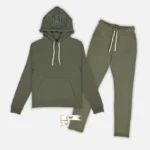When choosing clothes for your baby, safety must always be your top priority. Choking hazards can arise from small decorative items on garments, such as buttons, bows, or sequins. These adornments might appear charming, but if they become detached, they pose serious risks. Babies have a natural tendency to explore with their mouths, making loose accessories especially dangerous. Clothing with poorly secured embellishments can quickly turn from a stylish outfit to a potential threat.
In addition to small decorative items, zippers, snaps, and drawstrings can also contribute to choking hazards if not properly designed or secured. For instance, zippers with dangling pulls can break or detach, leaving small pieces within your baby’s reach. Ensuring all attachments are securely fastened and regularly inspected can help prevent these issues.
Parents should also be mindful of labels and tags, as these can irritate a baby’s skin or become a choking hazard if torn off. Opting for tagless clothing or labels that are securely sewn into the fabric can mitigate this risk. Safety standards for baby clothes often focus on the elimination of choking hazards, so it’s essential to check for compliance with these guidelines when shopping for garments.
The Importance of Choosing Safe Fabrics
Selecting the right fabric for your baby’s clothing is equally vital. Harmful fabrics can cause skin irritation, rashes, or even respiratory issues in sensitive infants. Synthetic materials, such as polyester and nylon, may seem convenient but often lack breathability and can trap heat, leading to discomfort or overheating. Babies have delicate skin that requires soft, natural fabrics to reduce the risk of irritation.
Organic cotton is widely regarded as a safe and comfortable option for baby clothing. It’s free from harmful chemicals and provides excellent breathability, keeping your baby cool and comfortable. Bamboo fabric is another excellent choice due to its natural antibacterial properties and softness. Avoid fabrics treated with flame retardants, as these chemicals can sometimes contain toxins harmful to your baby’s health.
Dye quality also plays a significant role in fabric safety. Brightly colored clothes often use chemical dyes that might not be suitable for babies with sensitive skin. Choosing garments labeled with non-toxic or natural dyes is a safer alternative. Regular washing of new clothes before use helps eliminate any residual chemicals and softens the fabric for added comfort.
Preventing Choking Hazards in Baby Clothing
Awareness is key when it comes to choking hazards. Inspect every piece of clothing carefully before dressing your baby. Look for loose threads, detachable buttons, or any small pieces that could come off. If you notice any potential risks, remove the unsafe elements or avoid using the garment entirely.
When purchasing baby clothes, check for certifications from recognized safety organizations. These certifications often indicate that the garment meets stringent safety requirements, including the absence of choking hazards. Brands that specialize in baby clothing often design their products with these considerations in mind, but it’s still important to remain vigilant.
Family bonding moments, such as welcoming a newborn, often include special outfits. Family matching hospital outfits are a popular choice for creating memorable first moments together. While selecting such outfits, ensure they meet safety standards, particularly for the baby’s clothing, which should prioritize comfort and eliminate choking hazards. Safe, coordinated outfits can make these occasions special without compromising your child’s well-being.
Another common issue is sizing. Ill-fitting clothes can create folds or excess fabric, increasing the likelihood of loose parts becoming a choking hazard. Always choose clothes that fit snugly but comfortably, allowing room for movement without excess material.
Proper Maintenance in Baby Clothing Safety
Caring for your baby’s clothing goes beyond just washing and storing. Regular maintenance ensures that garments remain safe for use. Inspect clothing after each wash to ensure embellishments, snaps, and seams remain intact. Washing machines and dryers can weaken these elements, making them more likely to come loose.
Hand washing delicate baby clothes or using gentle machine cycles can help preserve the integrity of the garments. Avoid harsh detergents, as their chemical residues can irritate your baby’s skin. Instead, opt for hypoallergenic and fragrance-free options that are safe for infants.
Storing baby clothes properly also plays a role in safety. Ensure garments are stored in clean, dry environments to prevent mold or mildew, which can harm your baby’s health. Rotate clothes frequently to check for wear and tear, especially in items worn regularly.
Building Awareness
Promoting baby clothing safety goes beyond your own household. Share your knowledge with other caregivers, friends, and family members who may interact with your child. Ensure everyone understands the importance of avoiding choking hazards and choosing safe fabrics for babies. This shared responsibility helps create a safer environment for your little one.
When gifting baby clothes, prioritize safety over style. Practical gifts made from natural, non-toxic materials and free of choking hazards are thoughtful and responsible choices. Encouraging safe clothing practices within your community can inspire other parents to prioritize safety as well.
Additionally, educating older siblings about choking hazards can make a difference. Teach them not to place small items near the baby’s clothing or crib, and involve them in choosing safe clothing options. This fosters a sense of responsibility and ensures the baby’s safety is a shared priority within the family.
Final Thought
Baby clothing safety requires attention to detail and a commitment to protecting your child from choking hazards and harmful fabrics. By carefully selecting clothes, inspecting them for potential risks, and maintaining them properly, you can create a safe and comfortable wardrobe for your little one. Remember, safety is always more important than aesthetics. Emphasizing this principle ensures that your baby can explore the world comfortably and securely. By sharing these practices with others, you help build a safer environment for all babies.








